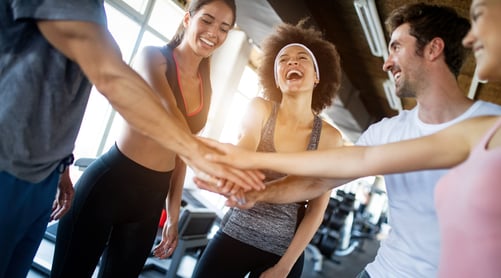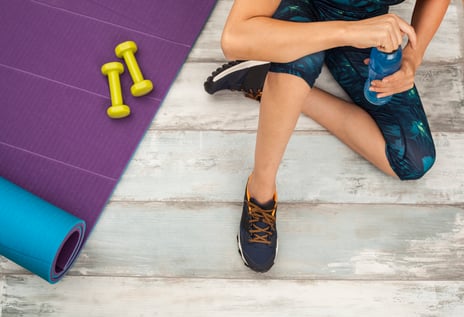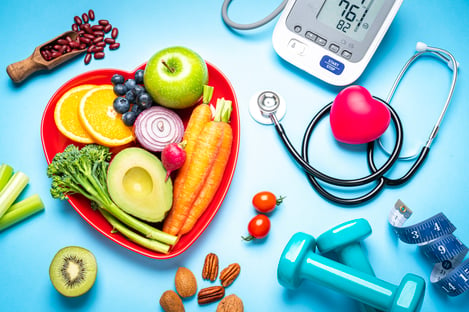Mental health is directly connected and dynamically influenced by our activity levels and our physical health. Why is this?
.jpg?width=335&height=223&name=GettyImages-2193875040%20(1).jpg) Physical activity is an integral part of keeping your body, mind, and spirit healthy. Regular physical activity supports cardiovascular health, bone density, muscle mass, disease prevention, and numerous other health benefits. How else does physical activity benefit us?
Physical activity is an integral part of keeping your body, mind, and spirit healthy. Regular physical activity supports cardiovascular health, bone density, muscle mass, disease prevention, and numerous other health benefits. How else does physical activity benefit us?
Stimulus and Our Brains’ Stress Responses
Physical activity stimulates both the Central Nervous System (CNS) and our Peripheral Nervous System (PNS) with signals about our environment, what we feel, our movement control, and our bodily functions.
Our incredible brains respond with what we call sympathetic and parasympathetic feedback responses. These signals regulate everything our body does. Without these signals coming to and from our brain and spinal cord, we wouldn’t react or function in any sense.
Sympathetic responses are related to stress and our “fight or flight” state. When we wake up, get nervous, or experience adrenaline, we release hormones like cortisol that activate our bodies to be ready for action. In these states, we breathe faster and start to divert most of our blood flow toward our muscles and extremities. We also typically do not have focused attention and are heightened in our awareness of everything. We may become hyperalert, agitated, and uncomfortable. These states are useful in short bouts during our daily lives.
Parasympathetic responses are related to our “rest and recover” states that allow us to calm down and return to our natural baseline. During these responses, we release hormones like acetylcholine that have relaxing and calming effects on all of our systems. Blood flow is more uniform across the entire body, and we feel at ease. We can offer more attention to fine details and think with greater clarity. We also experience sensations of hunger, tiredness, and contentment. This state supports our long-term health by ensuring our nutrition and sleep needs are addressed.
Progression into poor states of mental well-being can be common when people become sedentary and don’t stimulate themselves with movement. Life’s stresses can accumulate, and in serious cases, people can develop depression, anxiety, and other concerns when they can’t self-regulate their sympathetic responses. What can we do to help support healthy responses to stress?
Physical Activity and Exercise – “Controlled Stress”
Physical activity benefits us by allowing our mind to release stress (reducing levels of hormones like cortisol) as we condition ourselves to relax after stress and exertion. When we engage in physical activity, we create a stress stimulus, and in response, our body releases catecholamines such as endorphins, epinephrine, and norepinephrine.
The Mental Wellness Benefits of Physical Activity
Exercise is simply structured physical activity. When we engage in physical activity, we expose ourselves to a controlled amount of physical stress that can lead to long-term adaptations, as well as short-term benefits. Common benefits that result from exercise include lower blood pressure, better insulin sensitivity, increased muscle mass, increased bone density, and increased stroke volume.
Our mental performance and focus can benefit from dopamine release influenced by physical activity. Some studies document short-term cognitive improvements in both working and episodic memory. Short-term focus and attention can be improved for hours after bouts of physical activity. Retention of long-term memory from working memory may also be enhanced as we transition through stages of sleep. This means that we may retain more information in our daily activities after physical activity and thus improve our ability to learn.
Another important mental benefit of physical activity is decreased stress levels due to lowered cortisol. This hormone can increase your blood pressure, disrupt digestion, cause depression, weight gain, and sleep issues. When we exercise, we allow our body to release catecholamines and reduce cortisol levels in the blood. This is one of the reasons we feel better immediately after exercise. Afterward, it’s common to experience lower blood pressure, feelings of contentment, achievement, and overall calmness.
One final benefit that is crucial to mention is improved sleep quality. Lower cortisol levels can help prevent or improve sleep disruptions and difficulty falling asleep. The combination of energy expenditure and hormonal responses following exercise enhances our sleep quality.
Why Not Engage in Physical Activity?
Exercise is a form of medicine that proactively improves our mind, body, and spirit. We can see improved stress response and management, enhanced focus and clarity, and better emotional well-being. Why wouldn’t you want to do something that can improve the quality of your life so dramatically?
Not sure where to start? Meet with a NIFS personal trainer to help you reach your goals!


 If you or someone you know is living with Parkinson’s Disease (PD), incorporating regular physical activity into daily life is one of the best ways to manage symptoms and support overall health. Exercise doesn't always mean traditional gym workouts — movement of any kind that supports balance, agility, aerobic capacity, and muscular strength can make a big difference.
If you or someone you know is living with Parkinson’s Disease (PD), incorporating regular physical activity into daily life is one of the best ways to manage symptoms and support overall health. Exercise doesn't always mean traditional gym workouts — movement of any kind that supports balance, agility, aerobic capacity, and muscular strength can make a big difference.
 Everyone knows that routine exercise benefits your heart and overall health in the long term, but what do those benefits look like? When we start exercising, we can experience benefits almost immediately, and even after months of training, our body continues to adapt. The key is to find a routine that best fits you and stick with it—because if we stop exercising, our body can lose the adaptations it made.
Everyone knows that routine exercise benefits your heart and overall health in the long term, but what do those benefits look like? When we start exercising, we can experience benefits almost immediately, and even after months of training, our body continues to adapt. The key is to find a routine that best fits you and stick with it—because if we stop exercising, our body can lose the adaptations it made. We all know regular exercise is great for your heart and overall health, but what does that actually mean? The truth is, the benefits of exercise can start almost immediately, and your body continues to adapt over time as you stick to your routine. The key is consistency: finding an exercise routine that works for you and maintaining it. If you stop exercising, your body can lose the adaptations it worked hard to achieve.
We all know regular exercise is great for your heart and overall health, but what does that actually mean? The truth is, the benefits of exercise can start almost immediately, and your body continues to adapt over time as you stick to your routine. The key is consistency: finding an exercise routine that works for you and maintaining it. If you stop exercising, your body can lose the adaptations it worked hard to achieve.
 As we get into the season of gratitude, it’s the perfect time to think about how we can strengthen our bodies and minds. This November, we’re super excited to kick off the holiday season with a Planksgiving Challenge! Whether you’re a fitness pro or just starting out, planks are a fantastic way to build your core strength, improve posture, and up your overall fitness game.
As we get into the season of gratitude, it’s the perfect time to think about how we can strengthen our bodies and minds. This November, we’re super excited to kick off the holiday season with a Planksgiving Challenge! Whether you’re a fitness pro or just starting out, planks are a fantastic way to build your core strength, improve posture, and up your overall fitness game.
 Looking to build strength that lasts a lifetime? Squats are a foundational movement that supports health, mobility, and longevity, yet many of us overlook this natural exercise due to our modern, sedentary lifestyles. Incorporating squats into your routine can help you stay strong, flexible, and resilient as you age.
Looking to build strength that lasts a lifetime? Squats are a foundational movement that supports health, mobility, and longevity, yet many of us overlook this natural exercise due to our modern, sedentary lifestyles. Incorporating squats into your routine can help you stay strong, flexible, and resilient as you age.

 Sodium, potassium, magnesium, calcium, phosphate, and chloride are all electrolytes, or minerals that fulfill essential roles within the body. More specifically, sodium, chloride, and potassium work together to maintain fluid balance within the body, while magnesium and calcium promote optimal muscle function and aid in energy metabolism.
Sodium, potassium, magnesium, calcium, phosphate, and chloride are all electrolytes, or minerals that fulfill essential roles within the body. More specifically, sodium, chloride, and potassium work together to maintain fluid balance within the body, while magnesium and calcium promote optimal muscle function and aid in energy metabolism.  Did you know that cardiovascular disease is one of the leading causes of death?
Did you know that cardiovascular disease is one of the leading causes of death? 
 There’s always an assumption that fitness professionals work out 2 hours a day, 7 days a week. They eat healthy all day long and never have any junk food. Basically people think that we are perfect and never make mistakes. I have been in the health and fitness industry for more than 10 years now and I can honestly say that couldn’t be further from the truth.
There’s always an assumption that fitness professionals work out 2 hours a day, 7 days a week. They eat healthy all day long and never have any junk food. Basically people think that we are perfect and never make mistakes. I have been in the health and fitness industry for more than 10 years now and I can honestly say that couldn’t be further from the truth.